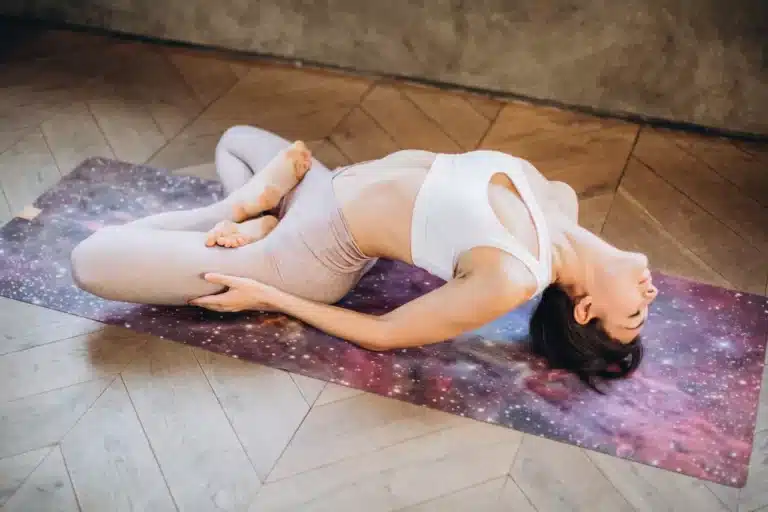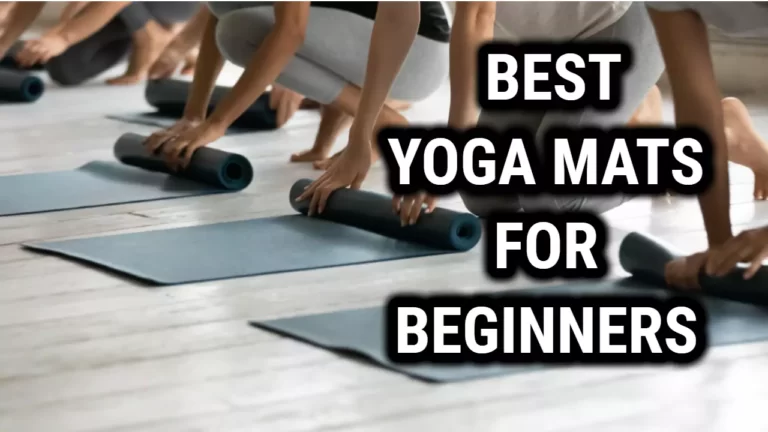Get Aligned with Your Practice: Yoga Mat with Alignment Lines

Do you struggle to find the proper alignment in your yoga practice? Are you constantly adjusting your body to make sure you’re in the correct position? If so, a yoga mat with alignment lines may be just what you need to enhance your practice.
A yoga mat with alignment lines is a mat that has lines or markers printed on it to help guide your body into proper alignment during yoga poses. These lines can help you improve your posture, prevent injury, and deepen your practice.
By using a mat with alignment lines, you can focus on your breath and the flow of your practice, rather than constantly adjusting your body.
Key Takeaways
- A yoga mat with alignment lines can improve posture, prevent injury, and deepen practice by providing a clear visual guide to body alignment and pose.
- Essential features to consider when choosing a yoga mat with alignment lines include thickness, material, durability, and non-slip surface.
- The ultimate goal of yoga is to align body, mind, and spirit, and personal preference plays a role in choosing the right material for your practice.
- To use a yoga mat with alignment lines effectively, focus on mastering the basics, gradually building strength and flexibility, and using the markings as a reference while still listening to your own body’s alignment and positioning.
Top Yoga Mats with Alignment Lines
- Liforme Original Yoga Mat
- Ananda Glow in the Dark Yoga Mat
- Keep Nature Rubber Premium Yoga Mat
- YogaDood Premium Thick Cork Yoga Mat
1. What Is Exactly A Yoga Mat With Alignment Lines
You’ll love using a yoga mat with alignment lines because it helps you perfect your form and get the most out of your practice. This type of yoga mat has an alignment system that includes lines and markers to guide your body alignment and pose.
With these lines, you can easily check and adjust your posture, making sure that you’re doing each pose correctly. Having alignment lines on your yoga mat can also help you improve your balance and stability.
By following the lines, you can make sure that you’re placing your hands, feet, and body in the right positions. This can prevent injuries and help you deepen your practice by allowing you to hold poses for longer periods of time.
With a yoga mat with alignment lines, you can focus on your breath and enjoy a more mindful practice.
2. Benefits of using a yoga mat with alignment lines
If you’re looking to improve your yoga practice, using a mat with alignment lines can be a game-changer. These lines help you achieve better alignment in poses, which can lead to a deeper stretch and better results.
Plus, the increased body awareness that comes with using an alignment mat can help prevent injuries and make your practice more effective overall.
Improved alignment in yoga poses
With the help of a yoga mat with alignment lines, you can effortlessly improve your alignment in various yoga poses. The position lines on the mat act as a guide for your body, helping you to maintain the correct alignment in each pose.
This can provide numerous benefits, including reducing the risk of injury, increasing the effectiveness of the pose, and enhancing your overall yoga practice.
To fully experience the benefits of using a yoga mat with alignment lines, it’s important to understand how the lines work. The position lines on the mat are strategically placed to help you align your body in the correct position.
By using the lines as a guide, you can ensure that your body is in the proper alignment, which is essential for getting the most out of each yoga pose. With consistent use, you will start to feel more confident in your yoga alignment and will be able to move more fluidly through poses.
Increased body awareness
Enhancing your awareness of your body’s movements and positioning can greatly improve your overall physical performance. With a yoga mat alignment system, you can easily enhance your body awareness in yoga poses.
The central line on the mat helps you align your hands and feet correctly, and the placement markers ensure that your body is in the correct position. Using a yoga mat with alignment lines helps you understand the alignment of your body while doing yoga poses.
The placement markers on the mat are designed to help you place your body in the correct position, which helps to avoid injuries and improve your posture. So, if you want to improve your body awareness and enhance your yoga practice, a yoga mat with alignment lines is a great investment.
Can help prevent injuries
You’ll be able to move with more confidence and fluidity when you have a better understanding of how your body should be positioned during each pose, which can ultimately help prevent injuries.
When using an alignment yoga mat, you’ll have a clear visual guide that will help you maintain proper alignment throughout your practice. This can help reduce the risk of injury and make your yoga practice more effective.
Here are some of the benefits of using an alignment yoga mat:
- The alignment lines on the mat make it easy to see where your hands, feet, and other body parts should be positioned during each pose.
- The non-slip surface of the mat provides a secure foundation, which can help prevent slips and falls.
- Using an alignment mat can help you develop better body awareness, which can improve your overall posture and alignment.
- With regular use, an alignment yoga mat can help you deepen your practice and achieve more challenging poses.
3. Features of a Good Quality Yoga Mat With Alignment Lines
When it comes to choosing a yoga mat with alignment lines, there are a few key features that you should keep in mind.
First and foremost, you want to make sure that the mat is thick enough to provide adequate cushioning and support for your joints.
Additionally, the material should be durable and able to withstand frequent use and wear and tear.
Finally, a non-slip surface is essential to ensure that you can maintain proper alignment and balance throughout your practice.
Thickness
Although a thicker yoga mat may provide more cushioning, it can also make it harder to feel the alignment lines beneath your feet. This is especially important for beginners who are still learning how to properly align their bodies during yoga practice. Alignment lines on a yoga mat are designed to help you align your body correctly, and a thicker mat may make it more difficult to do so.
That being said, the thickness of a yoga mat is still an important mat feature to consider. If you have sensitive joints or need extra cushioning, a thicker mat may be more comfortable for you. Just be sure to choose a mat with clear and visible alignment lines, so you can still align your body correctly.
Remember, the ultimate goal of yoga is to align your body, mind, and spirit, so choose a mat that will help you achieve that.
Material
Choosing the right material for your practice can make a significant difference in how comfortable and slip-resistant your mat will be. When it comes to yoga mats with alignment lines, there are a few materials to consider.
The most common materials used for these mats are TPE (thermoplastic elastomer), PVC (polyvinyl chloride), and cork. TPE mats are an eco-friendly option as they’re made from non-toxic materials and are biodegradable. They’re also cushioned and provide good grip, making them perfect for beginners.
PVC mats, on the other hand, are known for their durability and affordability. They’re easy to clean and maintain, making them a popular choice for yogis who practice frequently. Cork mats are a newer option that’s gaining popularity due to their natural antibacterial properties and excellent grip, especially when wet. These mats are also environmentally friendly and offer a unique texture that some yogis prefer.
Ultimately, the choice of material comes down to personal preference and how it feels underfoot during your practice.
Durability
You want a mat that can withstand your daily practice without showing signs of wear and tear too quickly. When searching for a yoga mat with alignment lines, it’s important to consider its durability. Here are some factors to guide you in your search:
- Look for mats made of high-quality rubber or other durable materials.
- A thicker mat can provide more cushioning and protection against wear and tear.
- Read reviews from other yogis who have used the mat to gauge its longevity and durability.
- Consider a trusted brand like Liforme, known for their durable and long-lasting mats.
Investing in a durable yoga mat with alignment lines is important for both your practice and your wallet. By considering the material, thickness, reviews, and brand, you can find a mat that will last through countless practices without losing its grip or alignment lines.
Non-slip surface
If you want to avoid slipping and sliding during your practice, it’s essential to find a yoga mat with a non-slip surface. The last thing you want is to be distracted by constantly readjusting your feet and hands.
Fortunately, many yoga mats now come with a specially designed surface that grips the ground and provides the necessary traction for precision movements. This is especially important for beginners who need guidance with their alignment and positioning.
One of the main benefits of a non-slip surface is that it helps you maintain your balance and stability throughout your practice. With alignment lines printed on the mat, you can also ensure that your hands and feet are in the right place, providing you with the necessary guidance for proper alignment.
A non-slip surface also means that you can focus on your breathing and movement, without worrying about slipping and sliding. So if you want to take your practice to the next level, investing in a yoga mat with a non-slip surface and alignment lines is a must-have.
4. How to Choose The Right Yoga Mat With Alignment Lines For You
When choosing the right yoga mat with alignment lines for you, consider your level of experience and the type of yoga you practice.
If you’re a beginner, you may want a mat with more guidance and support, while experienced yogis may prefer a thinner mat for better balance.
Different types of yoga may require different features in a mat, such as extra grip or cushioning.
Make sure to choose a mat that suits your needs and helps you achieve your yoga practice goals.
Consider your level of experience
As a beginner or experienced yogi, you’ll appreciate the guidance provided by the alignment lines on this mat. The lines help you to properly align your body during each pose, which is essential for preventing injuries and getting the most out of your practice. With the help of the lines, you can easily see if your hands, feet, or hips are in the correct position, and make adjustments as needed.
If you’re a beginner, the alignment lines on this yoga mat can be especially helpful. They provide clear instruction on where to place your body, which can be confusing when you’re just starting out.
As you become more experienced, you may find that you rely less on the lines, but they can still be a useful tool for refining your alignment and taking your practice to the next level.
Overall, a yoga mat with alignment lines is a great investment for anyone looking to improve their practice and get the most out of each pose.
Consider the type of yoga you practice
Considering the style of yoga you prefer, it’s important to choose a mat that complements your practice and enhances your overall experience. When it comes to choosing a yoga mat with lines, there are a few things to keep in mind.
Here are four factors to consider:
- Design: Look for a mat with clear and visible alignment lines that are easy to follow during your practice. This will help you maintain proper form and avoid injuries.
- Practice: Consider the type of yoga you practice and choose a mat that suits your needs. For example, if you practice hot yoga, look for a mat with anti-slip technology that can handle sweat and moisture.
- Position: Think about the positions you’ll be practicing and choose a mat that provides enough space for you to move comfortably. A mat that’s too small can be frustrating and hinder your practice.
- Ideal: Lastly, consider what you want to achieve from your practice and choose a mat that helps you reach your goals. Whether it’s improving your flexibility, strength, or balance, choose a mat that supports your journey.
By taking these factors into account, you can choose a yoga mat with lines that enhances your practice and helps you reach your full potential.
5. Tips for Using a Yoga Mat With Alignment Lines
When using a yoga mat with alignment lines, it’s important to start slowly and not push yourself too hard. Use the lines as a guide, but don’t feel like you have to strictly adhere to them.
Remember to practice regularly in order to see improvement in your alignment and overall practice.
Start slowly
Take it easy and ease into your practice on the yoga mat with alignment lines. Starting slowly is key to preventing injury and building a strong foundation.
As a beginner, it’s important to take the time to understand the precise alignment cues provided by the lines on the mat. Don’t rush into complicated poses right away. Instead, focus on mastering the basics and gradually building your strength and flexibility.
Starting slowly also means taking breaks when necessary and listening to your body. Don’t push yourself too hard, especially if you’re not used to the specific alignment cues provided by the mat.
Remember, the goal is to improve your practice and prevent injury, not to show off your skills. So, take it easy, be patient, and focus on developing a solid foundation for your yoga practice on the mat with alignment lines.
Use the lines as a guide, not a strict rule
The lines on the floor are a helpful guide, but don’t feel like you have to strictly follow them for every pose. Your yoga mat with alignment lines is designed to help you with your poses, but it’s important to remember that it’s just a tool.
It’s there to guide you, not to dictate every movement you make. When using the lines as a guide, keep in mind that everyone’s body is different. What works for someone else may not work for you, and that’s okay.
Use the lines to help you find proper alignment, but don’t be afraid to make adjustments if something doesn’t feel quite right. Remember that yoga is about finding your own practice and listening to your body.
So use the lines as a guide, but trust yourself and your own instincts as well.
Practice regularly to see improvement
Consistent practice is key to seeing progress and improvement in your yoga journey. While the alignment lines on your yoga mat can be helpful in guiding your poses, they shouldn’t be taken as strict rules to follow.
Instead, use the markings as a reference and focus on your own body’s alignment and positioning. Regular practice will help you develop muscle memory and strengthen your body, allowing you to hold poses for longer and with proper alignment.
It’s important not to get discouraged if you don’t see immediate improvement. Remember that progress takes time and dedication. We recommend practicing at least a few times a week to see the best results.
As you continue to practice, you may find that you rely less on the alignment lines and more on your own intuition and body awareness.
FAQ’s
Q: What is an alignment yoga mat?
A: An alignment yoga mat is a specially designed yoga mat that features lines and markers to help you align your body into the correct positions for each yoga pose.
Q: How does an alignment yoga mat work?
A: The lines and markers on an alignment yoga mat show you exactly where to place your hands, feet, and other body parts in each pose. This helps you achieve proper alignment, which can improve your balance and prevent injuries.
Q: What is the Liforme yoga mat?
A: The Liforme yoga mat is a popular brand of alignment yoga mat that features a unique alignment system called the “AlignForMe” system. This system uses a series of lines and markers to help you align your body into the correct positions for each pose.
Q: Can you provide a review of the Liforme yoga mat?
A: The Liforme yoga mat is a high-quality mat that offers excellent grip, durability, and alignment assistance. Many customers report that it has helped them achieve more precise body alignment in their yoga practice.
Q: What is the design of an alignment yoga mat?
A: Alignment yoga mats typically have a non-slip surface, are lightweight, and come with a body alignment system that features position lines and markers to help you achieve proper alignment in your yoga poses.
Q: How does an alignment system help with yoga alignment?
A: An alignment system provides a visual guide for correct body alignment in different yoga positions. By following the position lines and markers on the mat, you can achieve more precise alignment in your poses, which can help improve your practice and prevent injuries.
Q: What are the benefits of using an alignment yoga mat?
A: Using an alignment yoga mat can improve your body alignment in yoga poses, which can result in better balance, improved flexibility, and reduced risk of injuries. It can also help you make progress in your yoga practice more quickly.
Q: What is the difference between an alignment yoga mat and a regular yoga mat?
A: A regular yoga mat typically does not feature position lines or markers, while an alignment yoga mat does. An alignment mat can help you achieve better body alignment and prevent injuries, whereas a regular mat is simpler and cheaper.
Q: What are some recommended brands of alignment yoga mats?
A: Some recommended brands of alignment yoga mats include Liforme, Ewedoos, Body By Yoga, and Manduka. These brands offer high-quality mats with good grip, durability, and alignment assistance.
Q: Do alignment yoga mats come with a bag?
A: Many alignment yoga mats come with a bag for easier shopping and transportation. However, it depends on the brand and model, so you should check the product specifications to see if a bag is included.





